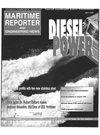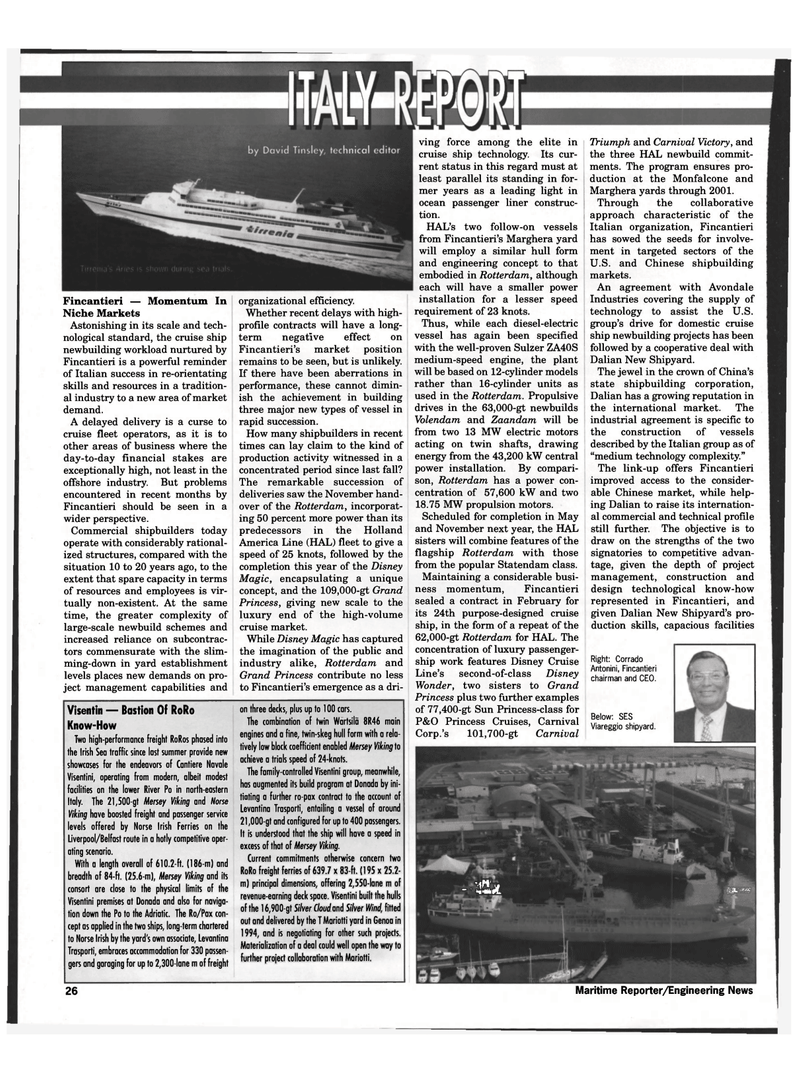
Page 26: of Maritime Reporter Magazine (July 1998)
Read this page in Pdf, Flash or Html5 edition of July 1998 Maritime Reporter Magazine
Fincantieri — Momentum In
Niche Markets
Astonishing in its scale and tech- nological standard, the cruise ship newbuilding workload nurtured by
Fincantieri is a powerful reminder of Italian success in re-orientating skills and resources in a tradition- al industry to a new area of market demand.
A delayed delivery is a curse to cruise fleet operators, as it is to other areas of business where the day-to-day financial stakes are exceptionally high, not least in the offshore industry. But problems encountered in recent months by
Fincantieri should be seen in a wider perspective.
Commercial shipbuilders today operate with considerably rational- ized structures, compared with the situation 10 to 20 years ago, to the extent that spare capacity in terms of resources and employees is vir- tually non-existent. At the same time, the greater complexity of large-scale newbuild schemes and increased reliance on subcontrac- tors commensurate with the slim- ming-down in yard establishment levels places new demands on pro- ject management capabilities and organizational efficiency.
Whether recent delays with high- profile contracts will have a long- term negative effect on
Fincantieri's market position remains to be seen, but is unlikely.
If there have been aberrations in performance, these cannot dimin- ish the achievement in building three major new types of vessel in rapid succession.
How many shipbuilders in recent times can lay claim to the kind of production activity witnessed in a concentrated period since last fall?
The remarkable succession of deliveries saw the November hand- over of the Rotterdam, incorporat- ing 50 percent more power than its predecessors in the Holland
America Line (HAL) fleet to give a speed of 25 knots, followed by the completion this year of the Disney
Magic, encapsulating a unique concept, and the 109,000-gt Grand
Princess, giving new scale to the luxury end of the high-volume cruise market.
While Disney Magic has captured the imagination of the public and industry alike, Rotterdam and
Grand Princess contribute no less to Fincantieri's emergence as a dri-
Visentin — Bastion Of RoRo
Know-How
Iwo high-performance freight RoRos phased into the Irish Sea traffic since last summer provide new showcases for the endeavors of Cantiere Navale
Visentini, operating from modern, albeit modest facilities on the lower River Po in north-eastern
Italy. The 21,500-gt Mersey Viking and Worse
Viking have boosted freight and passenger service levels offered by Norse Irish Ferries on the
Liverpool/Belfast route in a hotly competitive oper- ating scenario.
With a length overall of 610.2-ft. (186-m) and breadth of 84-ft. (25.6-m), Mersey Viking and its consort are close to the physical limits of the
Visentini premises at Donada and also for naviga- tion down the Po to the Adriatic. The Ro/Pax con- cept as applied in the two ships, long-term chartered to Norse Irish by the yard's own associate, Levantina
Trasporti, embraces accommodation for 330 passen- gers and garaging for up to 2,300-lane m of freight on three decks, plus up to 100 cars.
The combination of twin Wartsilii 8R46 main engines and a fine, twin-skeg hull form with a rela- tively low block coefficient enabled Mersey Viking to achieve a trials speed of 24-knots.
The family-controlled Visentini group, meanwhile, has augmented its build program at Donada by ini- tiating a further ro-pax contract to the account of levantina Trasporti, entailing a vessel of around 21,000-gt and configured for up to 400 passengers.
It is understood that the ship will have a speed in excess of that of Mersey Viking.
Current commitments otherwise concern two
RoRo freight ferries of 639.7 x 83-ft. (195 x 25.2- m) principal dimensions, offering 2,550-lane m of revenue-earning deck space. Visentini built the hulls of the 16,900-gt Silver Cloud and Silver Wind, fitted out and delivered by the T Mariotti yard in Genoa in 1994, and is negotiating for other such projects.
Materialization of a deal could well open the way to further project collaboration with Mariotti. ving force among the elite in cruise ship technology. Its cur- rent status in this regard must at least parallel its standing in for- mer years as a leading light in ocean passenger liner construc- tion.
HAL's two follow-on vessels from Fincantieri's Marghera yard will employ a similar hull form and engineering concept to that embodied in Rotterdam, although each will have a smaller power installation for a lesser speed requirement of 23 knots.
Thus, while each diesel-electric vessel has again been specified with the well-proven Sulzer ZA40S medium-speed engine, the plant will be based on 12-cylinder models rather than 16-cylinder units as used in the Rotterdam. Propulsive drives in the 63,000-gt newbuilds
Volendam and Zaandam will be from two 13 MW electric motors acting on twin shafts, drawing energy from the 43,200 kW central power installation. By compari- son, Rotterdam has a power con- centration of 57,600 kW and two 18.75 MW propulsion motors.
Scheduled for completion in May and November next year, the HAL sisters will combine features of the flagship Rotterdam with those from the popular Statendam class.
Maintaining a considerable busi- ness momentum, Fincantieri sealed a contract in February for its 24th purpose-designed cruise ship, in the form of a repeat of the 62,000-gt Rotterdam for HAL. The concentration of luxury passenger- ship work features Disney Cruise
Line's second-of-class Disney
Wonder, two sisters to Grand
Princess plus two further examples of 77,400-gt Sun Princess-class for
P&O Princess Cruises, Carnival
Corp.'s 101,700-gt Carnival
Triumph and Carnival Victory, and the three HAL newbuild commit- ments. The program ensures pro- duction at the Monfalcone and
Marghera yards through 2001.
Through the collaborative approach characteristic of the
Italian organization, Fincantieri has sowed the seeds for involve- ment in targeted sectors of the
U.S. and Chinese shipbuilding markets.
An agreement with Avondale
Industries covering the supply of technology to assist the U.S. group's drive for domestic cruise ship newbuilding projects has been followed by a cooperative deal with
Dalian New Shipyard.
The jewel in the crown of China's state shipbuilding corporation,
Dalian has a growing reputation in the international market. The industrial agreement is specific to the construction of vessels described by the Italian group as of "medium technology complexity."
The link-up offers Fincantieri improved access to the consider- able Chinese market, while help- ing Dalian to raise its internation- al commercial and technical profile still further. The objective is to draw on the strengths of the two signatories to competitive advan- tage, given the depth of project management, construction and design technological know-how represented in Fincantieri, and given Dalian New Shipyard's pro- duction skills, capacious facilities
Right: Corrado
Antonini, Fincantieri chairman and CEO.
Below: SES
Viareggio shipyard. -•'42* A >. V 26 Maritime Reporter/Engineering News

 25
25

 27
27
